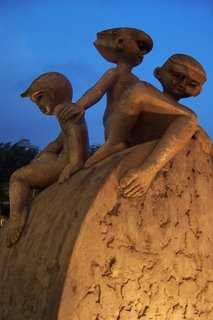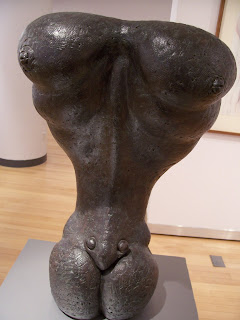 Ng Eng Teng's Red Face (1986). Ciment Fondu, Paint and Lacquer.
Ng Eng Teng's Red Face (1986). Ciment Fondu, Paint and Lacquer.
Away from the hustle and bustle of city life, located within the premises of the National University of Singapore, is the
NUS Museum. This museum houses the following three art collections:
- The Chinese art collection displayed at the Lee Kong Chian Art Museum
- The South and Southeast Asian collection displayed at the South and Southeast Asian Gallery
- The Ng Eng Teng collection
I have visited the Ng Eng Teng Gallery at the then National University of Singapore Museums several years ago, and I dare say it was my favourite section of the museum. However, when I went to visit the
NUS Museum slightly more than a month ago, I was fairly disappointed to see that the Ng Eng Teng Gallery was closed, temporary. I read that the Ng Eng Teng gallery was closed for the installation of new works.
The consoling part was that there was a section in the museum that displayed some of the works by Ng Eng Teng. The collection on display was way lesser than what I had seen several years ago, and I could only be thankful that such arrangements was temporary.
My favourite section of the NUS Museum continues to be the Ng Eng Teng collection, perhaps because I find it easier to relate to Ng Eng Teng's work. Furthermore, I find the collections of Ng Eng Teng's works tend to have a more consistent and congruent theme compared to the works from the museum's other collections.
Admittedly, I have had fond memories of the Ng Eng Teng Gallery. I regularly visited the Ng Eng Teng Gallery at least once a week when it was located nearby the Central Library of NUS. Each time I visited it, I would get inspired by at least one of the works. I still remember being greeted by Ng Eng Teng's
Freedom Child every time I visited the gallery when it was located nearby the Central Library. Given its relatively good collection of Ng Eng Teng's works, it was rather disappointing that the gallery did not get as many visitors as it should deserve.
There is something quite sensual and aesthetically pleasing about Ng Eng Teng's works. Viewing his works also reminds of the days when I had to read up about his work and his life as an artist when I was taking Art History at Secondary School level. Looking back, I am glad that it was a must to study Art History then. I realised that art can be better appreciated if one were to understand the context in which it was created, and one way to understand the context was to study Art History.
If appreciating the context would to be important, then it would be a must for me to include a short section about Ng Eng Teng (1934 - 2001) in this post first:
As best as I can recall, Ng Eng Teng made his mark as a sculptor. Ng Eng Teng is inspired by the human condition and its many nuances, and perhaps that is why:
"The human figure remains Eng Teng's principal source of inspiration and, no matter how abstract, his works, from the earliest, tentative explorations to these mature, masterful creations, always retain some link with figuration. (view source)"
It hence brings me much delight to share with you Ng Eng Teng's
Red Face. In this work, the artist turns the head upside down with lips pointing upwards. This defies the customary presentation of the head, and I find it quite cool and humourous. It also challenged the viewer to see things beyond the conventional perspectives. I personally find this work very interesting, and that the lips have been very well shaped. So are the eyes.




The maquette of
The Climb also caught my attention. I had seen the actual life-size sculpture of
The Climb near HDB Hub. It was actually a work commissioned by the Housing Development Board for the then HDB headquarters in Bukit Merah, Singapore.
 The maquette of The Climb.
The maquette of The Climb.
 Life size sculpture of The Climb, now located near HDB Hub
Life size sculpture of The Climb, now located near HDB Hub
The maquette of
Wealth and
Contentment also caught my eye. I remember that when I was a young child, the life-size sculpture of
Wealth stood right at
Plaza Singapura. In those days, I remember that the departmental retail store
Yaohan was still in operation. My mother would take me and my younger brother there, and I remember there was a section in the then
Yaohan departmental store for children to play
Legos bricks.
To be honest, at that age, I won't go specially to
Plaza Singapura to see the sculptures. Yet, it would be difficult to miss
Wealth and
Contentment since they are relatively large and were placed at fairly prominent spots of the then
Plaza Singapura. As such, when my Art History teacher first gave us a lecture on Ng Eng Teng's
Wealth and
Contentment, I could almost instantaneously recognise that they were the sculptures located at the then
Plaza Singapura.
At the NUS Museum, I read that
Wealth was commissioned by DBS Land for Plaza Singapura and later it was donated to NUS in 1997.
Wealth now stands just outside the University Cultural Centre of NUS. Personally, I prefer the sculpture
Contentment to
Wealth.
 Maquettes of Wealth and Contentment.
Maquettes of Wealth and Contentment.
I recommend that one should check out Ng Eng Teng's
Mother and Child series. It is one of my favourite series from Ng Eng Teng's works. There was only one sculpture from the series that I saw when I was at the NUS Museum about more than a month ago. I find that there is a nice sense of sensitivity in the way that Ng Eng Teng dealt with the subject matter of "Mother and Child". The lines of the sclptures from this series tend to show a kind of tenderness and nurturing love.
If you like "Mother and Child" series, I would strongly recommend that you could check out the "Father and Child" series. Sad to say, there was no work from this series on display when I last visited the NUS Museum. The "Father and Child" series by the late Ng Eng Teng demonstrates paternal love, and what I like about this series is that it features the playful moments in father-child relationship. I hope that this series would be featured some day.
For those who enjoy seeing works that are more abstract in nature, try checking out Ng Eng Teng's
Torso-to-Face series. I find it one of the fascinating series by Ng Eng Teng. Those torso-like sculptures actually look like faces. I think there is quite a lot of creativity in visualising and transforming torso-like sculptures into face-look sculptures.
Just simply see
Cobra I right below. Do you find that the torso-like chest looks quite like a face with eyes?

 Cobra I, (1997). This work belongs to a sculptural series that emerged after 1994 from Ng Eng Teng's Torso-to-Face drawings.
Cobra I, (1997). This work belongs to a sculptural series that emerged after 1994 from Ng Eng Teng's Torso-to-Face drawings.
And if you have a liking for even more abstract works, you may like
Acrobat I, (1994).

Some of you may be awed by Ng Eng Teng's subdued mastery of sculpture forms, and if you wish to know the secrets behind how he achieved such mastery, be sure to read this article:
A Short Note on Dr Ng Eng Teng by Lim Tai Wei.
Meantime, I shall look forward to the reopening of the Ng Eng Teng gallery. I hope that would come soon.
***
Information on the museum:
NUS Museum
University Cultural Centre Annex
50 Kent Ridge Crescent
National University of Singapore
Singapore 119279
Tel: (65) 65164 617 / 6
Opening Hours
10am to 5pm (Mondays to Saturdays)
Closed on Sundays and Public Holidays
Admission is FREE
***
References:
Ng Eng Teng: An Overview
http://scholars.nus.edu.sg/post/singapore/arts/painters/channel/19.html
http://www.easterntea.com/research/fineart.htm
Ng Eng Teng Gallery
The Sculpture of Ng Eng Teng: A Selected List
http://www.a2o.com.sg/a2o/public/search/index.html
Also visit:
NUS Museum
Restoration and Repair to the Late Dr. Ng Eng Teng's Sculpture, Contentment 1974 at NUS, UCC.
http://www.nusantara.com/pasta/home/theartwo/contentm.html
Wealth and Contentment just outside University Cultural Centre

























